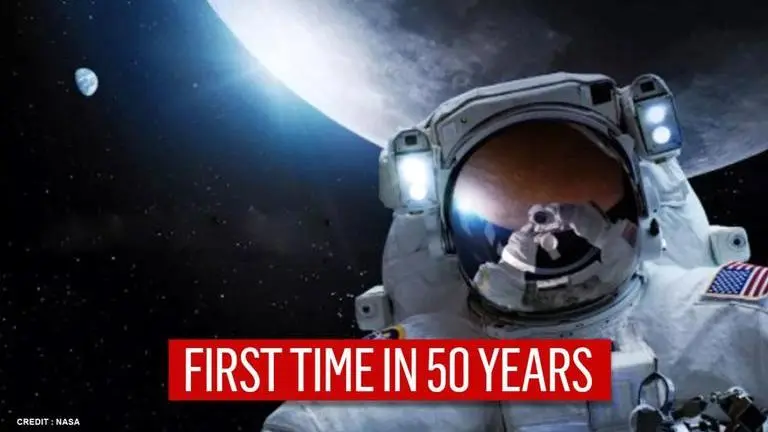Updated 10 December 2020 at 05:42 IST
NASA forms 'Science Definition' team for Artemis III lunar mission in 2024
NASA will have its Science Definition Team conduct research about volcanism, volatiles, impact processes, tectonics, and other details about lunar environment.
- Science News
- 3 min read

In its 'Science Definition' Artemis 3 report, NASA revealed that it will train its astronauts to perform complicated scientific tasks for the first crewed lunar surface mission planned in 2024. The mission will usher the human exploration and development in deep space learning that will answer fundamental planetary science questions, according to NASA.
After 50 years since humans first landed on the moon, in its modern era lunar touchdown, NASA will have its Science Definition Team conduct extensive research about volcanism, volatiles, impact processes, tectonics, and other details about the lunar environment. Astronauts will also conduct new advances arising from robotic lunar missions, will reanalyse older data, and perform sample analysis of the lunar surface.
"The optimal sample-return program is built upon geologic-context observations made by well-trained astronauts, aided by modern tools and real-time communication with scientists on Earth," NASA officials said in the report.
Advertisement
It is part of the human spirit to explore.
— Moonbound with #Artemis (@NASA) December 9, 2020
Today, we’d like to introduce you to our @NASAArtemis team — the initial team of @NASA_Astronauts who will help pave the way for our next human missions on and around the Moon: https://t.co/AiXfUyP6zl pic.twitter.com/LMJ0nNlE2N
Science Definition Team’s Objectives, Goals, and Investigations identified by the Science Mission Directorate in the Artemis Science Plan include:
- Understanding planetary processes
- Understanding the character and origin of lunar polar volatiles
- Interpreting the impact history of the Earth-Moon system
- Revealing the record of the ancient sun and our astronomical environment
- Observing the universe and the local space environment from a unique location
- Conducting experimental science in the lunar environment
- Investigating and mitigating exploration risks
We are returning to the Moon, and preparing to go beyond to Mars. Today we are proud to share our portraits of the #Artemis Team — the initial team of @NASA_Astronauts that will pave the way for human missions to the Moon. @NASAArtemis 📷 https://t.co/38sQBVcpHn pic.twitter.com/DBDYmW99NH
— NASA HQ PHOTO (@nasahqphoto) December 9, 2020
Today, we introduced the eighteen @NASA_Astronauts who will form the @NASAArtemis team. They'll use their diverse range of backgrounds, expertise, and experience to pave the way for humans to return to the Moon, to stay: https://t.co/f7H0Gm0WxM pic.twitter.com/iALdUPTmt1
— Moonbound with #Artemis (@NASA) December 9, 2020
Advertisement
The investigations on the lunar surface will be prioritised in a way that felicitates a more robust scientific understanding of the moon which will help advance the follow-up lunar missions and will help develop the Artemis Base Camp. "A more detailed mission operations plan will need to be developed by NASA when HLS system capabilities, a landing site, and other architectural details come into sharper focus," the space agency informed in the report.
Crew to stay for 6 and a half days
Under the Artemis program, NASA astronauts will stay on the moon for up to 6 and a half days and the crew for the Artemis 3 mission will be selected in 2022 or 2023, the space agency informed in a press briefing. Human astronauts can perform complicated tasks on the moon easily such as drilling cores and digging trenches, compared to robots, Sarah Noble, lunar program scientist in NASA's science mission directorate reportedly said.
The humans achieving the scientific goals will be an advancement of their capabilities compared with robot artificial intelligence and artificial imaging. NASA plans to impart geology expeditions and training similar to that given to Apollo astronauts in the 1970s.
Like the Apollo missions, @Astro_Jessica says that @NASAArtemis will have profound positive impacts and benefits for technology and culture. pic.twitter.com/4uvW6aSf8C
— Moonbound with #Artemis (@NASA) December 9, 2020
The #Artemis generation stands ready to prove what is possible. Together, we will define a new era of lunar exploration that doesn’t stop at the Moon, rather, prepares humanity for our next giant leap, Mars. I am pleased to announce the @NASAArtemis team: https://t.co/XIgF6JqJJ6
— Jim Bridenstine (@JimBridenstine) December 9, 2020
(Images Credit: NASA)
Published By : Zaini Majeed
Published On: 10 December 2020 at 05:42 IST

